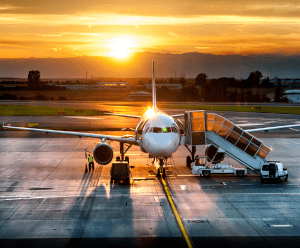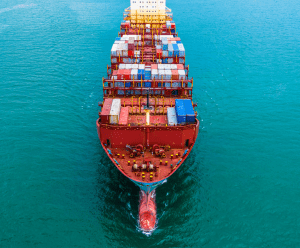
A tale of two canals

On 23 March 2021, the container ship Ever Given rammed its bow into the eastern bank of the Suez Canal. The waterway remained blocked until 29 March, and the domino impact on supply chains was felt for months afterward.
Disastrous as the Ever Given debacle was, a potentially greater disruption threatens maritime trade lanes right now.
War in the Middle East is already causing diversions away from the Suez Canal. Simultaneously, a severe drought is hitting water levels on the Panama Canal and causing delays, higher costs, and vessel re-routings.
Combined, more than 35,000 ships transit the Suez Canal and Panama Canal each year, carrying everything from oil to toilet paper, hot tubs to food. These man-made passages are two of the world’s top five shipping lanes by volume.
Niki Frank, CEO, DHL Global Forwarding Asia Pacific, said that DHL was monitoring developments at both Canals with concern. “It is unprecedented that two of the world’s trade arteries face such intense pressure at the same time, but shipping always finds a way,” he added. “We’ll be watching developments around both Canals closely, and keeping customers fully informed about any ramifications for ocean supply chains."
War in the Middle East diverts trade from the Suez
One spillover of the war between Israel and Hamas is that commercial vessels in international waters in the southern Red Sea came under attack from Houthi drones and missiles fired from Yemen.
Following Houthi rebel attacks against commercial shipping in the Bab al-Mandab strait, all carriers have suspended their services via the Red Sea and through the Suez Canal, rerouting most vessels via the Cape of Good Hope until a safe passage can be guaranteed.
Understandably, Israeli carrier Zim was quick to divert its vessels from the Suez to the longer Cape of Good Hope shipping route. But the missile attack on a U.K.-owned and an Orient Overseas Container Line (OOCL)operated ship on 3 December broadened the threat to all ships passing through the Red Sea, even those that have no links to Israel. More carriers are now diverting ships.
By one estimate from Lynerlitica, an intensification of ship attacks in the Red Sea, the key link to the Suez Canal, could tie up 30 percent of the container ship fleet as more vessels will need to be rerouted.
The DHL Ocean Freight Market Outlook 2024 report noted that the rerouting significantly increases transit times between Asia and Europe by 10 - 15 days, absorbing capacity. While it remains to be seen if some carriers will deploy additional tonnage to compensate for longer trips or if they will skip some sailings, services in and out of Europe and the Middle East, and into Africa for Mediterranean ports used as transshipment points have been affected.
Sailings from Asia to the East Coast of the Americas may also be impacted as shipping lines have started to divert vessels to avoid congestion in the Panama Canal due to vessel transit limitations resulting from low water levels.
The DHL report further stated that the situation is expected to have ripple effects on all global shipping routes in Q1 2024, as capacity is redeployed and equipment shortages will likely happen due to the delays.
“If 30 percent of global shipping has to go via Africa rather than Suez, delivery times are going to be extended by weeks, and ocean carrier pricing will be impacted,” explained Michael Every, Global Strategist at Rabobank.
In the meantime, the U.S.-led naval protection force ‘Operation Prosperity Guardian’ has been created in response to the attacks. Apart from the U.S., participating countries include Bahrain, Canada, France, Italy, the Netherlands, Norway, the Seychelles, Spain, and the U.K..
Panama Canal drought
Simultaneously, over on the Panama Canal, low water levels linked to the El Nino effect continue to hit operations.
Peter Sand, Chief Analyst, Xeneta, calls bottlenecks at the Panama Canal chokepoint a “slow-burning disaster”, with one vessel operator reportedly paying nearly US$4 million to jump the line as vessel delays mount.
The number of ships expected to be allowed to pass in February has been halved from an average of 36 to 38 per day in the past, to just 18. 20 container ships were waiting to transit in late November, according to liner database eeSea.
The Panama Canal Authority has also reduced draft levels, meaning ships are transiting with less cargo. “We face less capacity, more trips, higher costs and a less efficient supply chain,” Paul Snell, chief executive officer of British American Shipping, whose company moves about 20,000 to 40,000 containers per year, told Fortune.
“A Fortune editorial noted that even if this rain returns this season, “traffic congestion and draft restrictions will linger long into 2024”.
As carriers divert ships around the cape, there is longer transit time and costs involved. Carriers have announced GRIs and are now imposing Panama Canal surcharges (PCC), prompting an increase in short-term rates.
For example, German carrier Hapag-Lloyd will introduce a US$130 (€118) per Twenty-foot Equivalent Unit (TEU) PCC on 1 January, while Cosco is set to introduce what it termed a Panama Canal Low Water Surcharge (PLW) of US$255 (€231) per TEU. Some carriers started re-routing U.S. East Coast trade from Asia via the Suez Canal, but the war in the Middle East is also putting that alternative route at risk.
“Depending on the inventory strategy and the ability to adjust to longer transit time, sectors with lower inventory may struggle more than those with higher inventory levels. Our recommendation to customers is to manage inventory while considering diversifying to multimodal options such as air freight, and express modes like China rail for Europe to keep inventory at healthy levels,” concluded Frank.
ALSO WORTH READING













 English
English